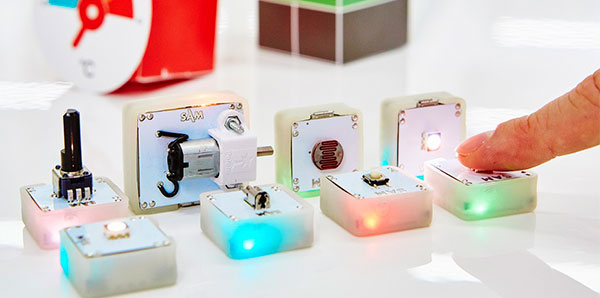Snapdragon and Qualcomm branded products are products of
Qualcomm Technologies, Inc. and/or its subsidiaries.
Developer of the month, Joachim Horn, founder and CEO of London-based start-up SAM Labs is convinced that kids can truly have fun while learning to code. You just need to give them the right toys. It also helps to make sure those toys are Bluetooth ready, and connect to the Internet of Things.

“SAM Labs sells toys that teach coding and engineering. It's an amazing combination of electronics, apps, and challenges, all connected via IoT,” Joachim said.
SAM, dubbed the “Lego of the Internet generation,” provides young makers with assorted wireless blocks (ranging from buttons and sliders to proximity and light sensors) that can be ordered in kits. Each kit can be configured for a variety of projects.
The beauty of SAM blocks is the wireless connectivity that occurs via Bluetooth Low Energy (BLE).
“We’ve used Bluetooth technology [from Qualcomm Technology International, Limited.] to provide wireless connections to our blocks, in order to hook them up to our app, SAM Space,” said Joachim. “The blocks perform various functions and when paired and connected, they form digital circuits.” The SAM Space app is available for OSX, Windows (64/32bit) and iOS.
“Without the Bluetooth capability, our wireless blocks couldn’t connect to one another without the use of physical connections,” Joachim said. “The BLE capability allows us to have blocks that connect digitally, are more aesthetically pleasing, and are easier to use.”
This video demo shows how to get started using a SAM Labs kit:
The company was named after Joachim’s younger brother, and the idea for the business came out of an “ah-ha” moment while travelling in Japan.
“I conceptualized SAM shortly after my graduation from Imperial College London, where I then travelled to Tokyo Institute of Technology to start a digital creative lab,” Joachim said. “While in Japan, I saw the market gap between simplistic toys and advanced prototyping techniques. Discovering this inspired me to realize my version of educational technology that would change learning forever: to make a toy that made coding, electronics and IoT seem friendly.”
SAM Labs ran a successful Kickstarter campaign in 2014, and they subsequently received support from Imperial Innovations, Microsoft Ventures, and Think Big. Most recently, the company secured £3.2m in venture capital from Imperial Innovations to help it reach more customers overseas and in the UK, and to sell their kits directly to schools. According to The Telegraph, more than 1,000 schools have already incorporated the kits into their teaching programs.
We recently had a chance to chat with Joachim to learn more about his vision for teaching toys, the work of SAM Labs, and how BLE makes it all click.
Can you share with us a fun fact about yourself?
I like to place small things around the office to see if people notice as a form of social experimentation. Currently, a silver stress ball brain is propped on a pole in a corner of the making area.
What is one thing that makes your company culture unique?
Operating in the same philosophy as our products: ‘learning through playing’, our in-house team always strives to challenge each other to learn and grow. By posing team challenges, holding productive and communicative weekly meetings, and participating in team building activities (such as Servo Yourself – a weekly themed lunch, or Hackathons), our team pulls equal weight in all directions and through challenges and encouragement.
Where do you and your team get inspiration for your work?
We are very inspired by students. To see how easily they can pick up SAM and start creating things, it’s incredibly stimulating.
When enduring a long day, how do you and your team stay energized?
We’re all big foodies around here and when we take breaks, we’re usually eating. We also do love our ‘Beers with Peers’ on Friday nights after a long week.

What projects are you and your company working on using Qualcomm technologies?
Using Qualcomm Bluetooth technology, we’ve created SAM Labs blocks (pictured above). Each of our blocks uses this technology to sync up to our app, SAM Space. The blocks perform various functions and when paired and connected, they form digital circuits.
From DC Motors to Vibration blocks, SAM blocks range in function and enable users to create inventions using the IoT in seconds. Currently, we have 15 blocks available for individual sale or packaged up in kits, so users may better understand how each block can interact with each other.
How did the specific Qualcomm product assist in the final development of your app?
The BLE capability allowed us to launch our app and successful wireless blocks, which sync up to it. The SDK provided helped us conceptualize Bluetooth-based solutions within the creation of SAM blocks and kits.
What do you love about embedded and IoT development?
I believe that IoT should be accessible to everyone. I am very happy that SAM and other devices are providing platforms where anyone can create their own IoT inventions in seconds.
Where do you see the IoT industry in 10 years?
The IoT will have a transforming effect on educational technology. An increasing number of students will be learning outside of the classroom while remaining connected. Internationally, students and teachers will be able to share what they have learned through cooperative learning.
What advice would you give to other developers?
Nobody will remember you – or blame you – for your failures; everybody will celebrate your successes. It's a great thing.
To learn more about the Bluetooth technology that powered SAM Labs, visit our CSR101x product family page on QDN.
Check out SAM Labs on Facebook, follow Joachim on Twitter, and view a TED Talk that he gave last year in London demonstrating his ideas for the next generation of inventors.

Comments
Re: Developer of the Month: Joachim Horn from SAM Labs...